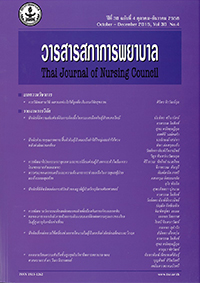การวิจัยผสานวิธี: ผสานอย่างไรให้ถูกต้องในงานวิจัยสุขภาพ
Keywords:
การวิจัยผสานวิธี, งานวิจัยสุขภาพ, เกณฑ์การประเมินคุณภาพ, mixed methods research, health research, evaluation criteriaAbstract
บทคัดย่อ: การวิจัยผสานวิธี : ผสานอย่างไรให้ถูกต้องในงานวิจัยสุขภาพ
การวิจัยผสานวิธีถูกนำมาใช้มากขึ้นในงานวิจัยสุขภาพ แต่การวิจัยประเภทนี้ยังมีข้อ ถกเถียงในชุมชนนักวิจัยอย่างกว้างขวางตั้งแต่ ความหมาย ปรัชญา กระบวนทัศน์ ระเบียบ วิธีวิจัย จนถึงการดำเนินการวิจัย บทความวิชาการนี้มีเป้าหมายเพื่อนำเสนอความรู้ และ แนวปฏิบัติของการวิจัยผสานวิธีมาใช้ในงานวิจัยได้อย่างถูกต้อง เหมาะสมที่สุดกับสถานการณ์ ที่ยังมีข้อถกเถียงกันอยู่นี้ สาระสำคัญของบทความเน้นการเสนอข้อถกเถียงที่สำคัญ ที่รวมถึง คำจำกัดความ กระบวนทัศน์ และเหตุผลของการใช้การวิจัยผสานวิธี รวมทั้งนำเสนอข้อยุติ ของข้อถกเถียง และตัวอย่างเกณฑ์การประเมินคุณภาพโครงร่างการวิจัย และรายงานวิจัย ที่ใช้การวิจัยผสานวิธี
Abstract: Mixed methods research (MMR) is increasingly used in health research. However, researchers’ community still debate over MMR. The debates are extensive, stretching from meaning, philosophy, paradigm, methodology, and implementation. This article aims to present knowledge and practice of MMR. It shows the usage of MMR in health research correctly and appropriately while the controversies over MMR are going on. Contents in the article focus on important controversies including meaning, paradigm and reasons of conducting MMR. In addition, it presents solutions of the debates and examples of criteria for evaluating research proposal and report using MMR.
Downloads
References
Plano Clark VL. The adoption and practice of mixed methods: U.S. trends in federally funded health-related research. QIX 2010; 16(6): 428-40.
Tariq S, Woodman J. Using mixed methods in health research. JRSM Short Reports 2010; Doi:10. 1177/2042533313479197.
Leslie AC, Krumholz M, O’Cathain A, Plano Clark VL, Cherliin E, Bradley H. Mixed methods in Bio¬medicine and health services research. AHA 2013; 6: 119-23.
Chirawatkul S, Patanasri K, Koochaisit C. Perceptions of menopause and health practices among women in Northeast Thailand. Nurs and Health Sci 2012; 4:113-21.
Chirawatkul S, Manderson L, Rukwong, P. Perceptions and experiences of villagers living with physical disability in Isan, Thailand. AJN 2008; 11:23-9.
Chirawatkul S, Jongudomkarn D, Kritiwatpaisarn W, Runreangkulkij S, Rujiraprasert N, Sawangchareon K, et al. Situations of teenage pregnancy: Perceptions of teenagers in 7 provinces of Thailand. JOH 2011; 21(5): 865-77.
Chirawatkul S, Shinlumprasert N, Songwatana P, Deowisaret W, Fongkaew W, Sindhu S, Runreangkulkij S. Happiness and attempt to retain in nursing profession. TJONC 2011; 27(4): 26-42.
Giddings LS. Mixed-methods research: Positivism dressed in drag? JRN 2006; 11(3): 195-203.
Morgan DL. Paradigms lost and pragmatism regained: Methodological implications of combining qualitative and quantitative methods. JMMR 2007; 1(1): 48-76.
Greene JC. Is mixed methods social inquiry a distinctive methodology? JMMR 2008; 2(1): 7-22.
Johnson R, Onwuegbuzie AJ. Mixed methods research: a research paradigm whose time has come. ER 2004; 33(7): 14-26.
Brewer J, Hunter A. Multimethod Research: A synthesis of styles. Newbury Park, CA: Sage; 1989.
Bryman A. Triangulation. In M. Lewis-Beck, A. Bryman, T F. Liao (Eds.). Encyclopedia of Social Science Research Methods. Thousand Oaks, CA: Sage; 2004.
Tashakkori A, Teddlie C. The past and future of mixed methods research: From data triangulation to mixed model designs. In A. Tashakkori & C. Teddlie (Eds.). Handbook of Mixed Methods in Social Behavioral Research. Thousand Oaks, CA: Sage; 2003. p. 671-701.
Tashakkori A, Creswell JW. The new era of mixed methods. JMMR 2007; 1(1): 3-7.
Creswell JW. Mapping the developing landscape of mixed methods research. In A. Tashkkori & C. Teddlie (Eds.). Handbook of Mixed Methods in Social Behavioral Research (2nd ed.) Thousand Oaks, CA: Sage; 2010. p. 45-68.
Creswell JW. Research Design: Qualitative, Quantitative and Mixed Methods Approaches (2nd ed.). Thousand Oaks, CA: Sage; 2003.
Creswell JW, Plano Clark VL. Designing and Conducting Mixed Methods Research. Thousand Oaks, CA: Sage; 2007.
Creswell JW. Controversies in Mixed Methods Research. In Denzin N. K., Lincoln Y. S. (Eds.). Handbook of qualitative research (4th ed.) Thousand Oaks, CA: Sage; 2011. p. 269-84.
Christ, T. Designing, teaching, and evaluating two complementary mixed methods research courses. JMMR 2009; 3(4): 292-325.
Teddlie C, Tashakkori A. Foundations of mixed methods research: Integrating quantitative and qualitative approaches in the social and behavioral sciences. Thousand Oaks, CA: Sage; 2009.
Morse JM, Niehaus L. Mixed method design: Principles and procedures. Walnut Creek, CA: Left Coast Press; 2009.
Johnson RB, Onwuegbuzie AJ, Turner LA. Toward a definition of mixed methods research. JMMR 2007; 1(2): 112-33.
Morse JM and Cheek J. Making room for qualitatively-driven mixed-method research. QHR 2014; 24: 3-5. Doi:10.1177/1049732313513656
Greene JC. Is mixed methods social inquiry a distinctive methodology? JMMR 2008; 2(1): 7-22.
Denzin NK, Lincoln YS. (Eds.). The SAGE handbook of qualitative research (3rd ed.). Thousand Oaks, CA: Sage; 2005.
Chirawatkul S. Qualitative research in nursing: Methods and case studies. Bangkok: Vitayapat; 2012.
Biesta G. Pragmatism and the philosophical foundation of mixed methods research. In A. Tashkkori , C. Teddlie (Eds.). Handbook of Mixed Methods in Social Behavioral Research (2nd ed.) Thousand Oaks, CA: Sage; 2010. p. 45-68.
Creswell JW, Plano Clark VL, Garrett AL. Methodological issues in conducting mixed methods research designs. In M.M. Bergman (Ed.). Advances in mixed methods research London: Sage; 2008. p. 66-83.
Greene JC, Caracelli VJ, Graham WF. Toward a conceptual framework for mixed-method evaluation designs. EEPA 1989; 11(3): 255-74.
Bryman A. Integrating quantitative and qualitative research: How it is done. QHR 2006; 6(1): 97-113.
Pensri R, Chirawatkul S, Markovic M. Suk-Sum-Bai: The quality of life perceptions among middle-aged women living with a disability in Isaan, Thailand. JNR 2007; 15 (4): 285-95.
Chirawatkul S. Manderson L. Perceptions of Menopause in Northeast Thailand: Contested Meaning and Practice. Soc Sci Med 1994; 39(11): 1545 - 54.
Stange K, Crabtree B, Miller W. Publishing multimethod research. Ann Fam Med 2006; 4(4): 292-4.
Morse J. Introducing qualitatively-driven mixed method design. QHR 2015; 25(6): 731-3.
Morse JM. Simultaneous and sequential qualitative mixed method design. QIX 2010; 16(6): 483-91.
O’Cathain A, Murphy E, Nicholl. The quality of mixed methods studies in health services research. JHSRP 2008; 13(2): 92-8.
Creswell J, Klassen AC, Plano Clark VL, Smith KC. Best Practice for Mixed Methods Research in the Health Sciences. Office of Behavioral and Social Sciences Research, National Institutes of Health; 2010.








